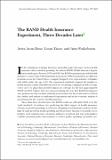| dc.contributor.author | Aron-Dine, Aviva | |
| dc.contributor.author | Einav, Liran | |
| dc.contributor.author | Finkelstein, Amy | |
| dc.date.accessioned | 2013-12-06T13:09:16Z | |
| dc.date.available | 2013-12-06T13:09:16Z | |
| dc.date.issued | 2013-02 | |
| dc.identifier.issn | 0895-3309 | |
| dc.identifier.issn | 1944-7965 | |
| dc.identifier.uri | http://hdl.handle.net/1721.1/82649 | |
| dc.description.abstract | Between 1974 and 1981, the RAND health insurance experiment provided health insurance to more than 5,800 individuals from about 2,000 households in six different locations across the United States, a sample designed to be representative of families with adults under the age of 62. More than three decades later, the RAND results are still widely held to be the "gold standard" of evidence for predicting the likely impact of health insurance reforms on medical spending, as well as for designing actual insurance policies. On cost grounds alone, we are unlikely to see something like the RAND experiment again. In this essay, we reexamine the core findings of the RAND health insurance experiment in light of the subsequent three decades of work on the analysis of randomized experiments and the economics of moral hazard. First, we re-present the main findings of the RAND experiment in a manner more similar to the way they would be presented today. Second, we reexamine the validity of the experimental treatment effects. Finally, we reconsider the famous RAND estimate that the elasticity of medical spending with respect to its out-of pocket price is -0.2. We draw a contrast between how this elasticity was originally estimated and how it has been subsequently applied, and more generally we caution against trying to summarize the experimental treatment effects from nonlinear health insurance contracts using a single price elasticity. | en_US |
| dc.description.sponsorship | National Institute on Aging (Grant R01 AG032449) | en_US |
| dc.description.sponsorship | National Science Foundation (U.S.). Graduate Research Fellowship Program | en_US |
| dc.language.iso | en_US | |
| dc.publisher | American Economic Association | en_US |
| dc.relation.isversionof | http://dx.doi.org/10.1257/jep.27.1.197 | en_US |
| dc.rights | Article is made available in accordance with the publisher's policy and may be subject to US copyright law. Please refer to the publisher's site for terms of use. | en_US |
| dc.source | American Economic Association | en_US |
| dc.title | The RAND Health Insurance Experiment, Three Decades Later | en_US |
| dc.type | Article | en_US |
| dc.identifier.citation | Aron-Dine, Aviva, Liran Einav, and Amy Finkelstein. “The RAND Health Insurance Experiment, Three Decades Later.” Journal of Economic Perspectives 27, no. 1 (February 2013): 197-222. © 2013 by the American Economic Association | en_US |
| dc.contributor.department | Massachusetts Institute of Technology. Department of Economics | en_US |
| dc.contributor.mitauthor | Aron-Dine, Aviva | en_US |
| dc.contributor.mitauthor | Finkelstein, Amy | en_US |
| dc.relation.journal | Journal of Economic Perspectives | en_US |
| dc.eprint.version | Final published version | en_US |
| dc.type.uri | http://purl.org/eprint/type/JournalArticle | en_US |
| eprint.status | http://purl.org/eprint/status/PeerReviewed | en_US |
| dspace.orderedauthors | Aron-Dine, Aviva; Einav, Liran; Finkelstein, Amy | en_US |
| dc.identifier.orcid | https://orcid.org/0000-0002-9941-6684 | |
| mit.license | PUBLISHER_POLICY | en_US |
| mit.metadata.status | Complete | |
